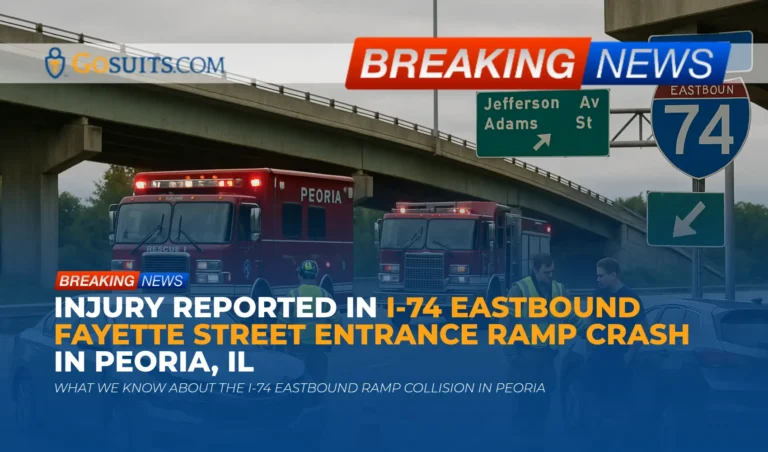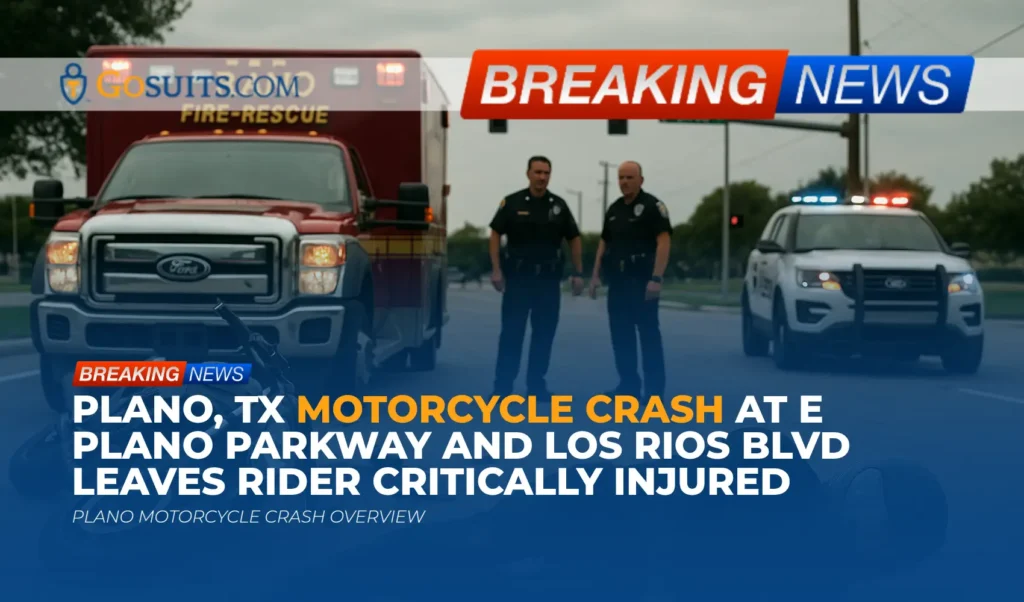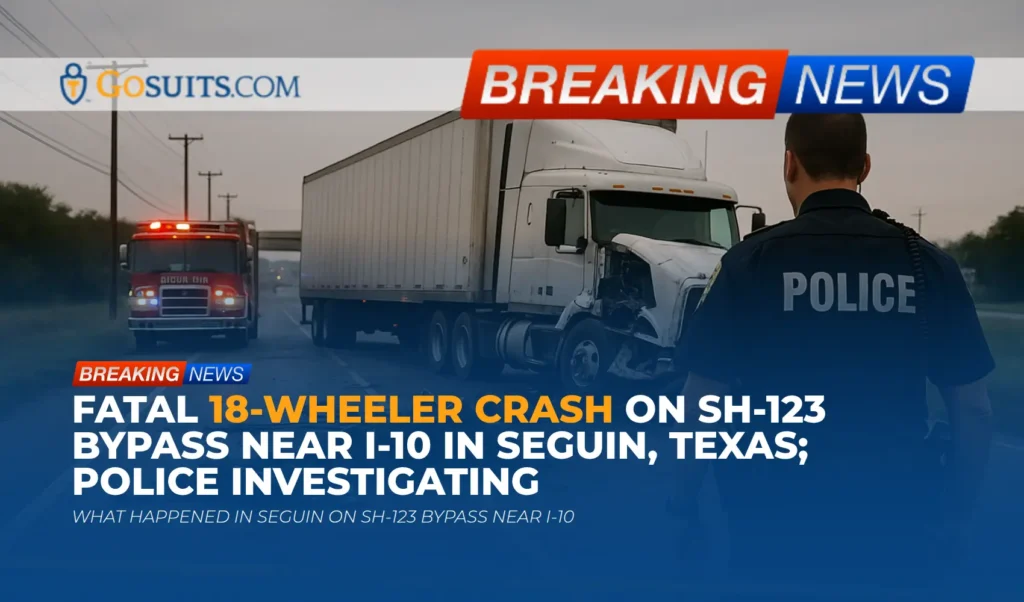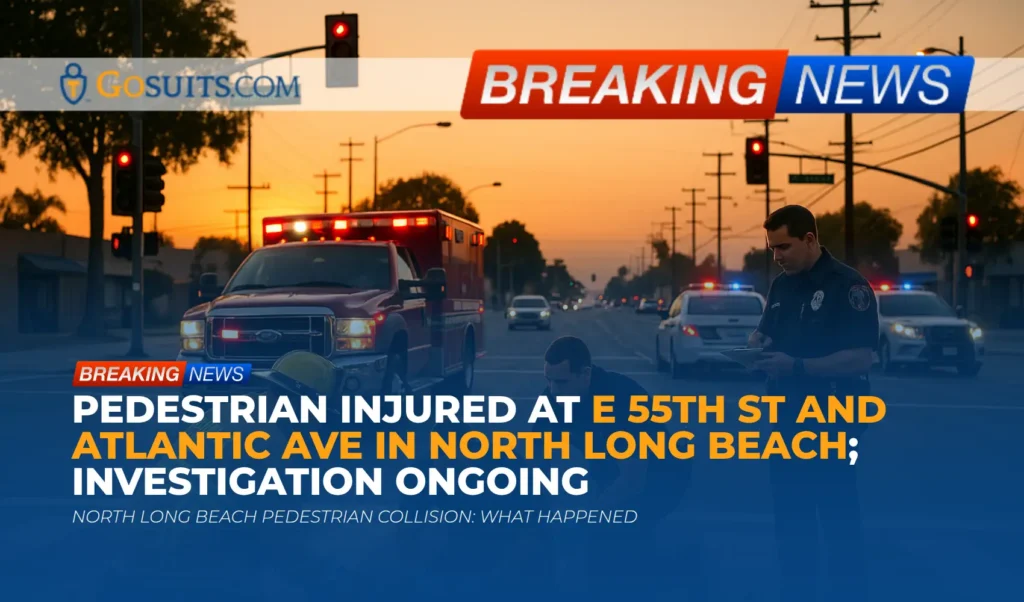- What we know about the I-74 eastbound ramp collision in Peoria
- Why entrance ramps are high‑risk merge zones in Illinois
- Common injuries after ramp crashes and why foot pain matters
- Immediate health and safety steps after a ramp collision
- How Illinois documents highway crashes and how to obtain key records
- Understanding liability and insurance after an Illinois ramp crash
- Preserving evidence unique to ramp collisions
- Time limits and deadlines that can affect your rights in Illinois
- Practical guidance for communications with insurance companies
- Local resources and public agencies in Peoria and Illinois
- Why acting promptly matters after a highway ramp collision
- Commentary from Gosuits Peoria, Illinois Personal Injury Attorney
What we know about the I-74 eastbound ramp collision in Peoria
According to radio dispatch information shared publicly, a traffic crash occurred around 1:10 p.m. on Monday, October 21, 2025, near the top of the entrance ramp that connects Fayette Street to eastbound I‑74 in Peoria. The scene was described as being near Jefferson Avenue and Adams Street. Rescue 1 and Engine 1 with Peoria Fire arrived promptly to provide care and to help manage traffic safety as responders cleared the ramp area. At least one person involved reported foot pain and was evaluated for injuries at the scene. Officials classified the event as an injury crash. At the time of the report, the number of vehicles involved and the exact cause of the collision had not been confirmed, and the incident remained under investigation.
We recognize that even when injuries are described as minor or limited to a single area like the foot, the pain and disruption can be significant. Ramp crashes also pose added hazards to responders and motorists due to space constraints and sight‑line limitations, which is why quick emergency response and careful traffic control are so important at these locations.
Why entrance ramps are high‑risk merge zones in Illinois
Entrance ramps require drivers to accelerate, judge gaps, and merge into moving traffic—often while navigating curves, elevation changes, or short acceleration lanes. These conditions increase the potential for rear‑end, side‑swipe, and short‑notice braking events, even at relatively modest speeds. Federal highway guidance recognizes that ramp segments have unique operational and safety challenges that call for careful design, signing, and incident management to reduce secondary collisions and delays. For background, see the Federal Highway Administration’s Ramp Management and Control guidance (FHWA Ramp Management and Control).
When crashes occur on ramps, the risk of a secondary collision rises because there is less room for vehicles to pull completely out of the travel path and approaching drivers have less time to react. The Federal Highway Administration’s Traffic Incident Management program highlights how quick clearance and coordinated response reduce risk to injured people and responders alike (FHWA Traffic Incident Management).
In Illinois specifically, crash trends and roadway safety initiatives are continually tracked and published by the Illinois Department of Transportation (IDOT). Statewide summaries and datasets can be reviewed on IDOT’s crash data portal (IDOT Illinois Roadway Crash Data), which provides context for where and how serious crashes occur, including on interchanges and ramps.
Common injuries after ramp crashes and why foot pain matters
Crashes during merging and low‑to‑moderate speed deceleration can transmit forces in unusual directions. Occupants may brace against the floorboard or pedals, leading to foot and ankle trauma. Even when external damage to a vehicle appears limited, occupants can sustain injuries such as sprains, ligament tears, metatarsal fractures, contusions, or tendon injuries. Pain with weight‑bearing, swelling, and reduced range of motion can interfere with work, caregiving, and daily activities.
Foot and ankle injuries are sometimes underestimated in the first hours after a crash. Swelling and bruising can develop over time, and some fractures are initially subtle on physical exam. Imaging, appropriate immobilization, and follow‑up care are important to promote healing and prevent long‑term instability or chronic pain. Recording symptoms early, keeping all medical appointments, and following provider instructions help both recovery and documentation.
In highway environments, responders often must work within very limited space. People who are ambulatory at the scene may decline transport, only to discover later that pain worsens. It is reasonable and prudent to seek timely medical evaluation after any collision with new pain, even if it seems minor at first.
Immediate health and safety steps after a ramp collision
These general steps can protect health and help create a clear record of what happened:
- Move to safety if possible. If the vehicle is drivable and it is safe to do so, move out of the live lane and onto the shoulder or a safe area as directed by responders. On ramps, space is limited; follow traffic control instructions.
- Request medical evaluation. Tell responders about all symptoms, even if mild. Foot, ankle, neck, and head pain can worsen with time. Ask what signs should prompt urgent re‑evaluation.
- Document the scene when safe. Photos or videos of vehicle positions, points of impact, skid marks, roadway conditions, debris fields, and signage can be valuable. If conditions are unsafe, prioritize personal safety and allow responders to manage the scene.
- Exchange information and identify witnesses. Obtain names, contact details, and insurance information for involved drivers and independent witnesses.
- Request the report number. Ask which agency is handling the crash report and note the incident or report number if one is provided.
- Follow up with a physician. If you were evaluated but not transported, consider scheduling a same‑day or next‑day medical visit to document symptoms and obtain appropriate imaging or referrals.
How Illinois documents highway crashes and how to obtain key records
Accident documentation is essential for understanding what happened and for any potential insurance claims. Multiple agencies may generate records. The following overview explains what exists and how to request it in Illinois. Always confirm the investigating agency before making a request.
Police crash reports
In Illinois, interstate ramp crashes within city limits may be investigated by the Illinois State Police (ISP) or a local police department, depending on jurisdiction and responder availability. If ISP handled the crash, certified crash reports can typically be requested online via the ISP portal (Illinois State Police Crash Reports). If a municipal department handled the investigation, request the report directly from that department’s records division.
Illinois law requires immediate notice to law enforcement for crashes involving injury or death (625 ILCS 5/11‑406). If officers did not respond, a motorist report may still be required in certain circumstances. When in doubt, ask the local agency for guidance on compliance and report availability.
911 recordings and dispatch logs
Emergency communications centers maintain audio and computer‑aided dispatch (CAD) logs that may show call times, dispatched units, and location data. These records are often obtainable through a public records request under Illinois’ Freedom of Information Act (5 ILCS 140), though portions may be redacted for privacy. To locate the correct 911 center, start with the city or county public safety communications office where the crash occurred, referencing date, time, and location details.
Fire department and EMS records
Responding fire and EMS agencies produce incident reports and patient care records. The patient (or authorized representative) can usually request copies directly. Some details may be protected by privacy laws. Note the responding units identified at this scene included Peoria Fire Rescue 1 and Engine 1. If a private ambulance was involved, that provider will have its own patient care report as well.
Traffic camera and roadway data
Portions of I‑74 and associated ramps may be monitored by state or regional traffic management systems. IDOT maintains traffic safety resources and accepts requests for certain records through its public information channels and FOIA portal. For statewide safety and crash analysis resources, visit IDOT’s crash data page (IDOT Illinois Roadway Crash Data). Public records requests to IDOT can be made through the department’s FOIA contacts listed on its site.
Coroner and autopsy records in fatal cases
This Peoria ramp crash was reported as an injury event, not a fatality. In the event a collision involves a death, the coroner’s office conducts death investigations and maintains related records. In Peoria County, the coroner is part of county government. General information and contact details can be found through the county’s official website (Peoria County Government), where the Coroner’s Office page provides office hours and request procedures. Coroner records have specific eligibility, timing, and privacy considerations under Illinois law.

Medical records
Hospital, urgent care, imaging, and physical therapy records document injury diagnosis and treatment. Patients have the right to obtain their own records. Keep discharge summaries, imaging reports, prescriptions, and any work‑restriction notes produced after the collision.
Understanding liability and insurance after an Illinois ramp crash
Every collision is fact‑specific, but there are recurring patterns in ramp incidents that inform how liability is analyzed and which insurance coverages may apply.
Negligence and right‑of‑way on ramps
On an entrance ramp, merging drivers must yield to traffic on the mainline until it is safe to enter. However, responsibility can be shared. Examples include:
- Unsafe merging or lane changes. Entering when a gap is inadequate, failure to signal, or drifting outside the lane across solid lines can be evidence of negligence.
- Speed mismatch and following distance. Abrupt braking or tailgating may contribute to rear‑end impacts on short ramps.
- Obstructed sightlines or short acceleration lanes. Design constraints may influence driver behavior, but they do not excuse unsafe actions.
- Weather and surface conditions. Wet or slick pavement, debris, or poor visibility can interact with driver decisions to produce loss‑of‑control or side‑swipe impacts.
Comparative fault in Illinois
Illinois follows a modified comparative fault system. A claimant’s recovery can be reduced by their percentage of fault and is barred if their fault exceeds 50 percent (735 ILCS 5/2‑1116). Investigations focus on lane positions, signaling, speed, witness accounts, vehicle damage patterns, and, where available, electronic data.
Insurance coverages that may apply
- Liability coverage of the at‑fault driver may address bodily injury and property damage claims within policy limits.
- Uninsured/Underinsured motorist (UM/UIM) coverage on your own policy can come into play if the at‑fault driver has inadequate insurance limits or is unidentified in a hit‑and‑run.
- Medical payments (MedPay) coverage may help with initial medical expenses regardless of fault, subject to policy terms.
- Collision coverage can address vehicle repairs or total loss valuations minus the deductible.
Insurance coverage questions are highly fact‑dependent. Before opening a claim or giving a detailed statement, consider getting a free consultation with a seasoned injury attorney to understand how coverage and Illinois law may apply to your situation.
Preserving evidence unique to ramp collisions
Evidence can fade quickly in highway settings. The following steps help preserve a clear record of what happened without compromising safety:
- Scene photographs and videos. Capture ramp signage, merge markings, advisory speeds, lane lines, shoulder width, curvature, and any obstructions like parked vehicles or work‑zone elements.
- Vehicle condition documentation. Photograph tire marks, wheel and suspension damage, pedal area intrusion, and floorboard deformation, which can relate to lower‑extremity injuries.
- Witness information. Independent witnesses often leave soon after lanes reopen. Ask responders if witness names were recorded in the CAD or police report.
- Vehicle telematics and EDR data. Many modern vehicles store short windows of pre‑crash speed, brake, and throttle data. Preservation can require prompt action.
- Footwear and assistive devices. If foot or ankle injuries are involved, keep footwear worn at the time of the crash and document any medical bracing, boots, crutches, or casts issued during care.
Time limits and deadlines that can affect your rights in Illinois
Deadlines can vary by claim type, involved parties, and insurance contracts. Examples include:
- Insurance notice deadlines. Policies require prompt notice of claims. Late notice can affect coverage. Review policy terms before contacting insurers, and consider speaking with an attorney first.
- Civil statute of limitations. In many Illinois personal injury cases, claims must be filed within two years of the incident (735 ILCS 5/13‑202). Different or shorter deadlines can apply in claims against governmental entities or for property damage. Do not rely on a single source; obtain specific legal advice for your circumstances.
- Public records retention. Some agencies purge 911 audio, dash‑cam, or non‑evidentiary video after a short period. Early requests help avoid loss of key evidence.
Because deadlines can be complex, early case review can help identify which time limits apply. Educational materials like statutes linked above are helpful, but individualized guidance can clarify how these rules operate in practice.
Practical guidance for communications with insurance companies
- Consult an attorney first, before contacting any insurer. What is said in an insurance statement can be used later to dispute fault or minimize injuries. A free consultation can help you understand your rights and prepare.
- Provide basic notice, not detailed narratives. If you must report promptly, limit initial contact to the date, time, location, and parties involved until you receive guidance.
- Be cautious with releases and authorizations. Broad medical authorizations can allow adjusters to mine unrelated medical history. Request tailored, time‑limited requests.
- Track all expenses and time missed. Keep receipts, mileage to medical care, and a log of missed work or activities affected by pain or mobility limits.
- Use the official crash report. The police crash report, once available, is a foundational document. If ISP investigated, it can generally be requested through the state portal (Illinois State Police Crash Reports).

Local resources and public agencies in Peoria and Illinois
These public agencies and resources can help with documentation and broader context. Always verify the correct investigating agency and keep your incident details handy when you inquire.
- Illinois State Police (ISP) — If ISP investigated, certified crash reports are typically available through the state’s portal: ISP Crash Reports.
- IDOT crash data and safety information — Statewide crash data, safety initiatives, and analytical summaries: IDOT Illinois Roadway Crash Data.
- FOIA requests for state records — Illinois Freedom of Information Act provides the process framework: 5 ILCS 140. IDOT’s website lists its FOIA contacts for requesting available traffic management or roadway records.
- Peoria County Government — For fatal cases or inquiries about death investigations, the Coroner’s Office information is available via the county’s site: Peoria County Government.
- Statutes relevant to crash reporting and claims — Crash reporting duty: 625 ILCS 5/11‑406; Comparative fault: 735 ILCS 5/2‑1116; General two‑year limitation for personal injury: 735 ILCS 5/13‑202.
- FHWA guidance on ramp operations and incident management — Ramp safety and operations: FHWA Ramp Management and Control; Traffic Incident Management overview: FHWA TIM Program.
Why acting promptly matters after a highway ramp collision
This section is intended to help readers understand urgency and next steps. It is not directed to any particular individual, and it is not a request to contact any law firm.
- Obtain medical evaluation quickly. Early diagnosis improves outcomes and creates a clear record linking symptoms to the crash date. Delays can complicate treatment plans and create disputes about causation.
- Secure official records while they exist. 911 audio, dash‑cam, and some traffic management footage may be overwritten within days or weeks. Submitting timely requests can prevent permanent evidence loss.
- Preserve vehicles and damaged items. Vehicles may be repaired, totaled, or moved to auction facilities quickly. Request a hold on the vehicle if impact analysis or data downloads might be needed.
- Mind insurance timeframes. Most policies require prompt notice after a crash. Gathering basic facts and understanding coverage early reduces the risk of missed deadlines.
- Be thoughtful about statements to adjusters. Early recorded statements can be used later. Consider seeking a free consultation with a qualified attorney before giving detailed accounts to any insurer.
- Track the full impact on daily life. A simple pain log, medication list, and missed‑work record helps providers and claim handlers understand how injuries affect mobility and function.
- Know the legal time limits. Illinois law imposes statutes of limitations that can bar claims if deadlines pass. Reviewing applicable limits early helps prevent avoidable loss of rights.
Commentary from Gosuits Peoria, Illinois Personal Injury Attorney
Our thoughts are with the person injured in this I‑74 ramp collision and with everyone affected by the disruption and uncertainty that follows. This article is intended for general information and educational purposes. It summarizes publicly reported details and offers context about Illinois roadway safety, documentation, and civil injury issues without speculating about fault.
Entrance ramps present uniquely tight spaces for drivers and responders alike. Based on what is known here—an injury crash near the top of the Fayette Street on‑ramp with emergency response by Peoria Fire—key questions will likely include how traffic was merging at the time, whether a speed or lane‑change mismatch occurred, and how the roadway geometry and visibility at the merge point affected decision‑making. Even comparatively low‑speed ramp impacts can lead to meaningful injuries, particularly to the lower extremities, and it is appropriate to take new foot or ankle symptoms seriously with diagnostic evaluation and follow‑up.
In our experience, insurance carriers and corporate entities may move quickly to collect statements or obtain broad medical authorizations before people fully understand their rights. Adjusters may focus on short ramps, advisory speeds, or vehicle photos to downplay the mechanism of injury, or may characterize foot and ankle pain as minor. Statements given early—especially without the benefit of complete medical records or the official crash report—can be used later to challenge causation, necessity of care, or time missed from work. Being informed before engaging with insurers helps prevent unintended waivers and incomplete narratives.
A no‑cost consultation with a skilled injury attorney can be an important step. It allows a confidential discussion about how Illinois law treats merging scenarios, what coverages may apply (including UM/UIM and MedPay), how comparative fault works, and what evidence should be preserved. It also provides guidance on the timing and content of insurance communications so that individuals can make informed choices about their next steps.
For those seeking documentation, the official police crash report is foundational. If the Illinois State Police investigated, reports are typically available through the state portal (Illinois State Police Crash Reports). For broader safety and crash context, IDOT’s statewide data is publicly available (IDOT Illinois Roadway Crash Data). In the very rare and tragic case of fatal outcomes, the Peoria County Coroner’s Office information is maintained on the county’s official site (Peoria County Government), and requests would follow applicable Illinois law. Above all, prioritizing health, preserving evidence, and obtaining accurate records early can make a meaningful difference in clarity and recovery.






